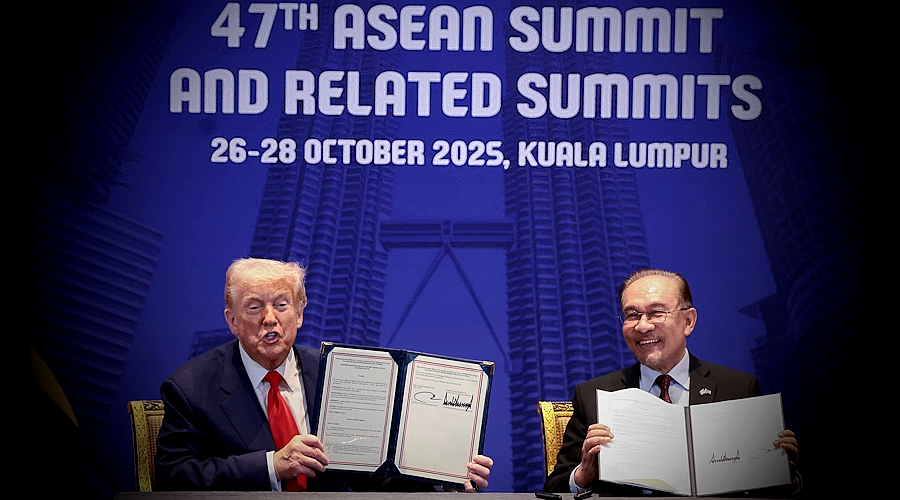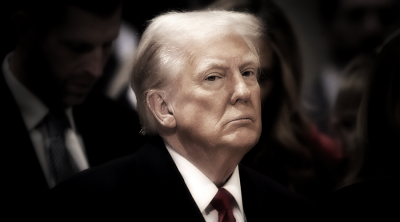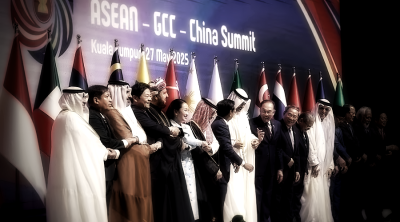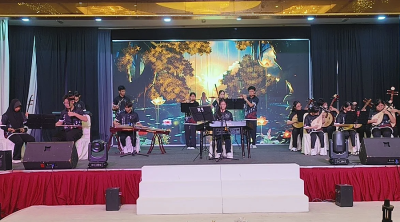Preamble
The recently signed U.S.–Malaysia Agreement on Reciprocal Trade (ARTA) marks a pivotal moment in Malaysia’s evolving trade strategy.
While publicly presented as a mutual liberalization initiative, ARTA reflects less of a free trade breakthrough and more of a strategic damage-control exercise—anchored in Malaysia’s attempt to secure stability amid intensifying U.S.–China economic rivalry.
Rather than broad liberalization, ARTA functions as a supply-chain alignment pact, designed to preserve Malaysia’s participation in the U.S.-led Indo-Pacific production ecosystem while insulating key sectors from external shocks.
Malaysia’s leadership appears to recognize that this agreement is less about accessing new markets and more about preventing exclusion from restructured global supply chains shaped by Washington’s “de-risking” and “on-shoring” agenda.
1. Tariff stability as geoeconomic insurance
Through ARTA, Malaysia successfully secured tariff stability across high-value exports—estimated at RM21.9 billion—covering electrical and electronics (E&E), palm oil derivatives, rubber-based medical devices, and pharmaceuticals.
However, many of these sectors are U.S.-dominated entities operating in Malaysia, including semiconductor packaging, testing, and high-precision components for U.S. and Japanese conglomerates.
This arrangement ensures continuity of Malaysia’s export-led model without substantially expanding domestic industrial depth. It thus represents a stabilization pact rather than an industrial upgrading mechanism.
The structure reinforces Malaysia’s semi-peripheral role—dependent on multinational value chains, while domestic value capture remains shallow with low-level assembling manufactured products.
2. The endurance of ethnocapitalism and the ‘red line’
Prime Minister Anwar Ibrahim’s insistence that Malaysia’s affirmative action policies remain intact during ARTA negotiations marks a continuation of the ethnocapitalist political economy embedded since the New Economic Policy (NEP).
His statement that such provisions are Malaysia’s “red line” reaffirms the state’s dual dependency—externally on global monopoly-finance capital, and internally on ethnically configured rentier capital.
This perpetuation of ethnocapital domains constrains Malaysia’s ability to fully leverage ARTA for structural reform.
Affirmative mechanisms remain captured by political patronage, inhibiting the rise of technologically competitive Bumiputera enterprises.
In essence, Malaysia’s bargaining power is circumscribed in some ways by its domestic class compromises.
3. Masking structural economic vulnerabilities
While ARTA delivers temporary export stability, it masks deeper macroeconomic vulnerabilities.
IMF and World Bank projections suggest Malaysia could experience a 0.76 percent decline in GDP growth by 2026, largely due to global demand slowdown, particularly from the U.S. and China.
A 1 percent contraction in U.S. GDP translates into a 0.8 percent reduction in Malaysia’s GDP, while a similar decline in China’s growth results in a 0.45 percent fall (World Bank, 2024).
Such high elasticity underscores Malaysia’s external vulnerability and the limited diversification of its economic structure.
Despite ARTA’s rhetoric of “resilient supply chains,” the treaty does not address Malaysia’s chronic dependence on intermediate manufacturing and commodity exports, nor its weak domestic technological ecosystems with her abysmal low 1 percent in total factor productivity index (TFP) and absent in a knowledge process regime.
It thus shall fail again, if not mindful, to insulate the economy from global downturn contagion effects.
4. Strategic diversion and the REE complication
The most geopolitically sensitive dimension of ARTA lies in rare earth elements (REEs).
Malaysia’s existing partnership with Lynas Corporation, an Australian firm aligned with U.S. strategic supply chains, places the country in a delicate balancing act vis-à-vis China, the world’s dominant REE processor.
By aligning REE extraction and processing more closely with U.S. and Australian interests, Malaysia risks losing potential bilateral innovation and processing collaboration with China, which has recently shown interest in joint green technology ventures.
ARTA’s implicit resource commitments could divert investment and market access away from Asian partners, effectively subordinating Malaysia’s REE policy to Washington’s containment strategy.
This reveals the trade diversion risk—where the rechanneling of investment and market orientation to politically “preferred” partners undermine broader South–South cooperation and long-term industrial sovereignty.

5. Policy implications: From stabilization to structural transition
ARTA’s geopolitical logic is understandable: it cushions Malaysia amid uncertain global conditions. However, the risk lies in policy complacency—where trade stability substitutes for structural reform.
Not only is Malaysia’s total factor productivity (TFP) remains stagnant, private investment-to-GDP ratio hovers below 17 percent, and innovation linkages that require knowledge inputs and processes are weak (OECD, 2023).
To transition from stabilization to transformation, Malaysia must pursue three structural priorities:
1. Deepen Domestic Industrial Ecosystems
Move beyond assembly-based participation by nurturing advanced materials, semiconductor design, and automation capabilities through local content mandates and public–private R&D platforms.
2. Reform Ethnocapital Structures
To replace patronage-based affirmative action with performance-linked industrial upgrading programs to build genuinely competitive Bumiputera enterprises.
3. Diversify Trade Linkages
Balance U.S. engagement under ARTA with strategic REE and green-tech collaboration with ASEAN and BRICS economies, mitigating overdependence on a single geopolitical axis.
Conclusion
ARTA provides short-term tariff predictability and access continuity, but it does not constitute a transformative trade breakthrough.
Instead, it represents a strategic act of economic damage control—a calculated attempt to remain relevant within present fragmenting global order.
By insulating U.S.-linked exports while maintaining domestic ethnocapital arrangements, Malaysia once again preserves short-term equilibrium at the cost of long-term autonomy.
Unless accompanied by structural industrial reforms and diversification of its global economic dependencies, ARTA may only delay the reckoning of Malaysia’s middle-income structural trap.
References:
Bloomberg. (2025, October). US.–Malaysia trade pact secures tariff stability for high-tech exports.
International Monetary Fund. (2024). World Economic Outlook Database. Washington, DC: IMF.
Nikkei Asia. (2025, October). Malaysia balances U.S. and China as REE race intensifies.
Organization for Economic Co-operation and Development (OECD). (2023). Economic Survey: Malaysia 2023. Paris: OECD.
South China Morning Post. (2025, October). Lynas expansion complicates China–Malaysia rare earth cooperation.
STORM (2025). malaysias-promised-chances-for-rare-earth-missed-opportunities-or-geopolitical-trap. Monsoonsstorms.wordpress.com
World Bank. (2024). East Asia and Pacific Economic Update: Regional Outlook. Washington, DC: World Bank.
(CS Loh is a retired private higher education institute lecturer, postgraduated as an development economist with reference to Southeast Asia from the School of Oriental and Asian Studies (SOAS), University of London.)
ADVERTISEMENT
ADVERTISEMENT








































